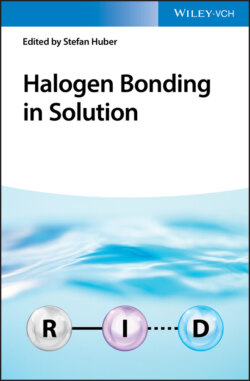Читать книгу Halogen Bonding in Solution - Группа авторов - Страница 16
1.1.5 Halogen Bond Features
ОглавлениеCharacteristics of the halogen bond have been established through experimental and theoretical means. From these studies several features of the halogen bond can be gleaned that should be considered in experimental and functional designs:
The halogen bond is a highly directional interaction. The R–X⋯Y angle tends to be close to 180°. This is due, in part, to the physical characteristics highlighted in Figures 1.1 and 1.2.
The halogen bond is highly tunable, with energies up to 200 kJ/mol [11].
Halogens are large atoms resulting in RX bonds, which are longer than R–H counterparts (e.g. vdW radii of 1.46, 1.82, 1.86, 2.04, and 1.20 Å for F, Cl, Br, I, and H, respectively [9]).
Halogen atoms are more hydrophobic than hydrogen atoms and the typical heteroatoms attached to them. Hydrophobicity of halogen atoms is a well‐established phenomenon commonly utilized in drug development where the introduction of a halogen atom into a drug will often result in a drug that is more apt to cross lipid bilayers [12].
Halogen atoms are more polarizable than hydrogens, providing the larger halogen bond donors with a suggested hard–soft acid–base complementarity with soft Lewis bases [13].
Despite the structural differences, both hydrogen and halogen bond donor strength can be tuned similarly by directly altering the donors (substituting heteroatoms and halogens, respectively) and by introducing stronger electron‐withdrawing groups on the R group. Nevertheless, halogen bond tunability is achieved in various ways:
By changing the halogen. A more polarizable halogen will result in a greater σ‐hole (e.g. I > Br > Cl > F). This trend is illustrated in Figure 1.2.
By changing the hybridization of the atom bound to the halogen. For example, with carbon, more s character increases the electron‐withdrawing ability, resulting in a larger σ‐hole on the attached halogen (e.g. C(sp) > C(sp2) > C(sp3)).
By altering the atom, the halogen is bound to (e.g. N–I > C–I).
By adjusting the electron‐withdrawing ability of adjacent moieties. Increasing the electron‐withdrawing ability of adjacent groups results in a greater σ‐hole leading to, in most cases, a more potent interaction. The opposite is true as well – an electron‐donating species will often diminish halogen bond strength.
By noncovalent cooperativity. Noncovalent cooperativity is an emerging strategy to enhance the interaction strength of noncovalent forces. The introduction of a hydrogen bond to the electronegative belt of the halogen further polarizes the halogen resulting in a more potent σ‐hole resulting in a hydrogen bond‐enhanced halogen bond [14–16].
